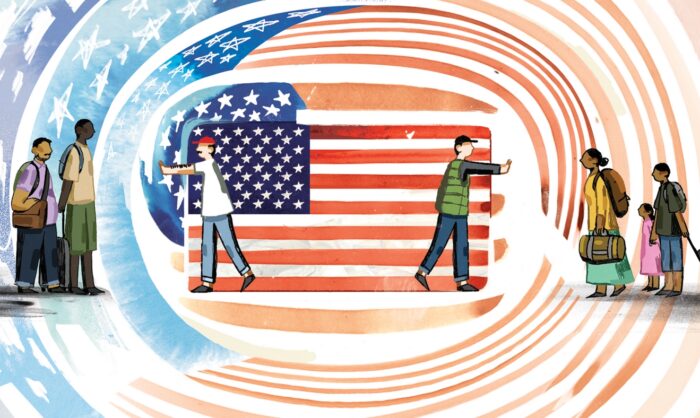
America’s promise as a land of opportunity and freedom has always attracted countless individuals and families from around the globe. Yet, the journey from aspiring migrant to legal resident or citizen is intricate, marked by a diverse array of pathways, opportunities, and challenges. This article explores the multifaceted aspects of U.S. immigration, shining a light on its complexities while breaking down these details into an understandable narrative.
Whether one is seeking temporary status or aims to become a permanent part of American society, understanding the avenues available is vital. Remember that legal help may very well be needed along the way in some cases. If this happens to be you, an experienced immigration law firm is what you should look for.
Non-Immigrant Visas

Among the many routes to enter the United States, non-immigrant visas offer temporary stay for specific purposes. These include visas for tourists, business visitors, students, and skilled professionals. Tourists may acquire a B-2 visa, which permits leisure travel, while business professionals can apply for a B-1 visa to attend meetings or conferences. Each visa category has unique requirements, restrictions, and time frames, making it essential to understand and follow the correct procedure.
Student visas, known as F-1, J-1, or M-1, are granted to those seeking education in the U.S. These visas require acceptance into a recognized institution and proof of financial stability. Temporary work visas like the H-1B permit skilled workers to fill specialty occupations. It is imperative for applicants to meet specific criteria and have a petition filed by a prospective employer. Non-immigrant visas offer valuable opportunities but demand a careful and accurate approach to their acquisition.
Immigrant Visa
An immigrant visa is a gateway for foreign nationals who wish to reside permanently in the United States. The process initiates with a petition from a U.S. citizen or lawful permanent resident sponsor, who must be a close family member or employer. This family-based sponsorship is central to family reunification and the strengthening of communities.
Employment-based sponsorship targets skilled professionals and can lead to a permanent stay in America. There are different preference categories for various qualifications and occupations. Overall, the immigrant visa pathway demands time, patience, and meticulous adherence to legal procedures, given its life-changing potential for the applicant.
Employment-Based Immigration

Employment-based immigration is a multifaceted process that allows U.S. companies to hire foreign nationals for specific roles. The EB-1 category, for instance, targets individuals with exceptional skills in arts, sciences, education, business, or athletics. People who qualify for this category are often leaders in their field.
A more complex category is the EB-5, which offers a path to residency for foreign investors willing to invest significant capital in a new commercial enterprise that creates jobs for U.S. workers. The investment requirements and processes can be intricate and must align with regulations. In sum, employment-based immigration is not just about filling job vacancies; it reflects a strategic alignment between foreign talent and American economic goals.
Adjustment of Status
Adjustment of status signifies the transition from a temporary non-immigrant status to lawful permanent residency, commonly known as obtaining a Green Card. It enables foreign nationals already in the U.S. to apply for permanent residency without returning to their home country. An approved immigrant petition, an available visa number, and eligibility criteria must be met to pursue this path.
Adjustment of status requires careful documentation and adherence to specific rules. Missteps can result in delays, denials, or even deportation. Legal guidance, a clear understanding of eligibility, and patience are key components in navigating this crucial step toward becoming a permanent resident.
Naturalization Process

Naturalization, the process of becoming a U.S. citizen, is an essential chapter in an immigrant’s journey. Eligible candidates must be lawful permanent residents for a specified period, demonstrate good moral character, and pass English and civics tests. A strong understanding of the U.S. government and history, as well as an allegiance to the Constitution, are expected.
In contrast to the eligibility requirements, the application process is meticulous and involves interviews and biometrics. Celebratory and life-affirming, naturalization ceremonies mark the culmination of a long process and symbolize a new citizen’s commitment to their adopted nation. The fulfillment of the American Dream resonates profoundly with this milestone.
Temporary Protected Status
Temporary Protected Status (TPS) serves as a humanitarian response to foreign nationals unable to return to their home country due to ongoing armed conflict, environmental disaster, or other extraordinary circumstances. Individuals granted TPS may not be deported and can obtain work authorization.
This protection, however, is not a path to permanent residency or citizenship and must be periodically renewed. TPS illustrates America’s commitment to human rights and its readiness to act as a sanctuary when circumstances in the home country pose a serious threat to personal safety or well-being.
Understanding the Green Card

The Green Card, formally known as the Permanent Resident Card, is a symbol of the holder’s right to live and work in the United States indefinitely. It’s attainable through family sponsorship, employment, the Diversity Visa Lottery, or humanitarian programs. Every year, countless individuals worldwide vie for this prized status, seeing it as a stepping stone to a new life.
Holding a Green Card comes with responsibilities, such as complying with all U.S. laws and filing taxes. It is neither citizenship nor a guarantee of permanent stay; certain actions or violations can lead to revocation. To many, the Green Card is not just a legal document but a tangible manifestation of dreams, aspirations, and a connection to the fabric of American society.
Temporary vs. Permanent Immigration
Temporary immigration serves specific, time-bound purposes such as tourism, study, or temporary work. Visas like the B-1, B-2, F-1, or H-1B fall into this category, reflecting a broad spectrum of reasons why people may wish to temporarily reside in the U.S. These visas are generally easier to obtain but offer limited rights and benefits.
Permanent immigration, in contrast, is a commitment to making the United States one’s permanent home. It provides the rights and responsibilities akin to citizenship, save for certain restrictions such as voting. The journey from temporary to permanent immigration can be arduous and complex, reflecting the profound transformation in one’s life and status. Understanding the differences and choosing the right path is essential for a successful immigration experience.
An experienced immigration lawyer, like Immigration Lawyer Houston, can be an invaluable resource in helping individuals navigate the complexities of both temporary and permanent immigration processes, ensuring they make informed decisions and successfully achieve their immigration goals.
Final Thoughts

From temporary sojourns to permanent settlements, the landscape of U.S. immigration is as vast and varied as the nation itself. The mosaic of opportunities and paths offers dreams and possibilities, yet it also demands diligence, understanding, and respect for the law. Whether it’s a non-immigrant visa for a brief business trip, a Green Card symbolizing a fresh start, or the profound act of naturalization, the American immigration system echoes the values, hopes, and dynamism that continue to make the United States a beacon for people worldwide.
















